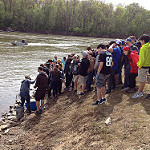Education and Outreach
Welcome Back to School and the Shad in the Classroom Program

Fish Biologist, Sam Pollock conducting a hatchery tour for teachers at the Edenton National Fish Hatchery in NC. Photo by the NC Museum of Natural Sciences.
Aug 16, 2016
By Lilibeth Serrano, Public Affairs Specialist
Children are naturally curious about water and fascinated by creatures that swim. The North Carolina Museum of Natural Sciences is banking on this premise to bring kids closer to nature and help recover the American Shad.
A new school year is here, which means over 600 new students will get the chance to go through the Shad in The Classroom experience. The North Carolina Museum of Natural Sciences educates teachers and they in turn educate their students about conservation. A teacher orientation and training session kicks off the activities early in the year. Teachers receive equipment and instruction for raising shad in the classroom. They learn ways to incorporate shad and aquatic ecology into their curriculum through immersive and hands-on activities. Discussions about key topics include the American shad’s survival, the species cultural and biological importance, its ecological connections to other species and habitats,and the significance of genetic integrity. The kids will get to know their local rivers better, help restore American shad and hopefully be inspired to become the biologists and ecologists of tomorrow.
The American shad fishery was once one of the East Coast’s most important. Unfortunately, water pollution, over-harvesting, and the blocking of spawning habitat by dams led to the shad’s decline. The Fish and Wildlife Service has been collaborating with the Shad in the Classroom program since it started in 2009. A lot of preparation is needed outside the classroom to ensure the kids get the most benefit. Throughout the school year, Museum staff coordinate the arrival of the eggs and the release of the larval fish with the schools, hatcheries, drivers, and fisheries biologists.
The highlight of the program is the week that the students raise and release the American shad fry, along the Neuse River and the Roanoke River to augment the local population. The kids also experience fish printing and fish dissection, and the Museum brings its traveling, inflatable immersion theater, the Geodome to some schools. Teachers report that because of the shad program, the students are much more aware of the organisms, the rivers, and the watersheds around them and the impacts that humans have on these resources.
 Students from the Vance Charter School release at the Roanoke River. Photo by the NC Museum of Natural Sciences, Shad in the Classroom Program, 2016.
Students from the Vance Charter School release at the Roanoke River. Photo by the NC Museum of Natural Sciences, Shad in the Classroom Program, 2016.
Collaboration among multiple organizations provides the resources needed to implement Shad in the Classroom. The Albemarle-Pamlico National Estuary Program (APNEP) invests $20,000-$25,000 per year on this project. The NC Museum of Natural Sciences offers in-kind support including program administration. The NC Wildlife Resources Commission provides additional logistical, physical, and financial aid. The USFWS provides technical assistance and $7,000 per year to financially support this effort. Graduate students from the North Carolina State University also provide their time delivering fish anatomy and dissection lectures.
Applications for Shad in the Classroom are available in the fall. To find out more visit the Museum of Natural Science Website.
Other Outreach Materials |

Fish and Wildlife Biologist John Ann Shearer helps children plant cinnamon ferns, wildflowers and blueberry shrubs in a new rain garden on the A.B. Combs Elementary campus. Credit: Teresa Furr.
Brochures:
Fact Sheets:
- USFWS in North Carolina
- Endangered Species in North Carolina
- Attracting Butterflies
- Beneficial Bats
- Bird Feeding
- Christmas Trees for Wildlife
- Hummingbird Haven
- Invasive Plants
- Native Plants
USFWS Outreach Links
Junior Duck Stamp Program



